Related Research Articles

A non-commissioned officer (NCO) is a military officer who does not hold a commission. Non-commissioned officers usually earn their position of authority by promotion through the enlisted ranks. In contrast, commissioned officers usually enter directly from a military academy, officer training corps (OTC) or reserve officer training corps (ROTC), or officer candidate school (OCS) or officer training school (OTS), after receiving a post-secondary degree.

Fragging is the deliberate or attempted killing of a soldier, usually a superior, by a fellow soldier. U.S. military personnel coined the word during the Vietnam War, when such killings were most often committed or attempted with a fragmentation grenade, to make it appear that the killing was accidental or during combat with the enemy. The term fragging now encompasses any deliberate killing of military colleagues.

The Royal Bermuda Regiment (RBR) is the home defence unit of the British Overseas Territory of Bermuda. It is a single territorial infantry battalion that was formed on the amalgamation in 1965 of two originally voluntary units, the mostly black Bermuda Militia Artillery (BMA) and the almost entirely white Bermuda Rifles, and the only remaining component of the Bermuda Garrison since the 1957 withdrawal of regular units and detachments from Bermuda.
The School of Infantry (SOI) is the second stage of initial military training for enlisted United States Marines after recruit training. The ITB now called IMC went from a 59 day course to 14 week course. Since the initial training pipeline is divided between coasts, Marines from areas east of the Mississippi River usually graduate from MCRD Parris Island and move on to SOI at SOI East, while those from the western half of the nation attend MCRD San Diego and move on to SOI West at the Camp San Onofre area of Camp Pendleton in California. Female Marines are trained at both SOI East and SOI West. The School of Infantry's training mission ensures "Every Marine is, first and foremost, a Rifleman". At SOI, Marines with the Military Occupational Specialty of infantry are trained at the Infantry Training Battalion (ITB), while all non-infantry Marines are trained in basic infantry and combat skills at the Marine Combat Training Battalion. SOI marks a transition in the professional training of entry-level students from basically trained Marines to combat-ready Marines.
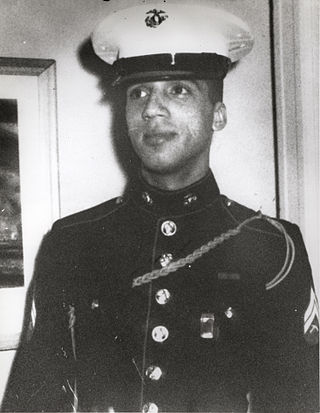
Rodney Maxwell Davis was a non-commissioned officer in the United States Marine Corps who was posthumously awarded the Medal of Honor for heroism above and beyond the call of duty in 1967, during the Vietnam War.

Allan Jay Kellogg Jr. is a retired sergeant major in the United States Marine Corps. He received the United States military's highest decoration, the Medal of Honor, for his actions as a staff sergeant on March 11, 1970, during the Vietnam War.
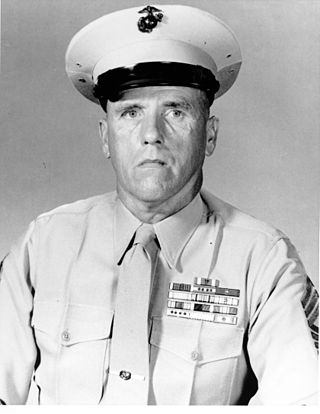
Thomas J. McHugh was a United States Marine who served as the 3rd Sergeant Major of the Marine Corps from June 29, 1962, to July 16, 1965.

The Marine Military Academy (MMA) is a private college preparatory academy located in Harlingen, Texas, US, offering a curriculum for boys in grades 7–12 plus one year of post-graduate study. The school was founded in 1965. Its traditions and ideals are inspired by the United States Marine Corps (USMC), but the school is not affiliated with the USMC except through its Junior ROTC program.

David W. Sommers is a retired United States Marine who served as the 11th Sergeant Major of the Marine Corps from 1987 to 1991.
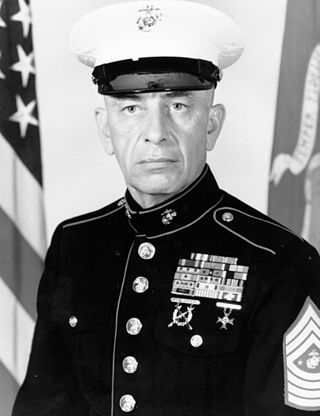
Henry H. Black was a United States Marine who served as the 7th Sergeant Major of the Marine Corps from 1975 to 1977.
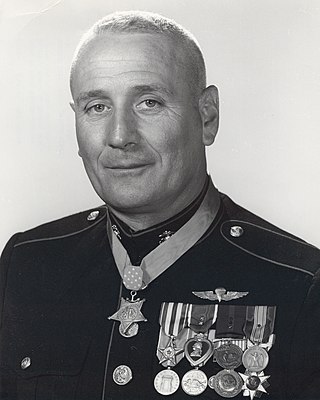
Jimmie Earl Howard was a Marine Corps staff sergeant when he led an eighteen-man reconnaissance patrol in a fierce battle against a battalion of Viet Cong in June 1966. As a result of his heroic actions, Howard became the sixth U.S. Marine to be awarded the nation's highest honor for heroism in combat in Vietnam. The Medal of Honor was presented by President Lyndon B. Johnson in White House ceremonies on August 21, 1967.

Sergeant Major Gilbert "Hashmark" Johnson was one of the first African Americans to enlist in the United States Marine Corps and one of the first African American drill instructors in the Marine Corps. Johnson was known as “Hashmark” because he had more service stripes than rank stripes. He retired in 1959 after 32 years of service in the U.S. armed forces, including 17 years as a Marine.
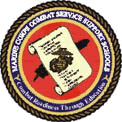
Camp Gilbert H. Johnson is a satellite camp of Marine Corps Base Camp Lejeune in Jacksonville, North Carolina and home to the Marine Corps Combat Service Support Schools (MCCSSS), where various support military occupational specialties such as administration, supply, logistics, finance, Navy corpsman and motor transport maintenance are trained. Camp Johnson is situated on Montford Point, the site of recruit training for the first African Americans to serve in the Marine Corps, known as "Montford Point Marines".

The Marine Corps noncommissioned officer's sword is a sword worn by noncommissioned officers (NCOs) and staff noncommissioned officers (SNCOs) of the United States Marine Corps. The NCO sword was adopted in 1859 and is patterned after the United States Army's foot officers' sword of 1850. The M1859 NCO sword continues service today as the Marine Corps drill and ceremonial sword. The sword's use is restricted by regulation to ceremonial occasions by an NCO or Staff NCO in charge of troops under arms or at weddings and wedding receptions where at least one of those being married is in uniform and has the rank of Corporal or higher.
Hispanics in the United States Marine Corps, such as Private France Silva who during the Boxer Rebellion became the first Marine of the thirteen Marines of Latin American descent to be awarded the Medal of Honor, and Private First Class Guy Gabaldon who is credited with capturing over 1,000 enemy soldiers and civilians during World War II, have distinguished themselves in combat. Hispanics have participated as members of the United States Marine Corps in the Boxer Rebellion, World War I, the American intervention in Latin America also known as the Banana Wars, World War II, the Korean War, the Vietnam War, the Gulf War and most recently in the military campaigns of Afghanistan and Iraq.
The U.S. Army Creed of the Noncommissioned Officer, otherwise known as the Noncommissioned Officer's Creed, and commonly shortened to the NCO creed, is a tool used in the United States Army to educate and remind enlisted leaders of their responsibilities and authority, and serves as a code of conduct. Each branch has their own version, and many have been altered over the years.

The USS Kitty Hawk riot was a racial conflict between white and black sailors aboard the United States Navy aircraft carrier Kitty Hawk on the night of 12–13 October 1972, while positioned at Yankee Station off the coast of North Vietnam during the Vietnam War.
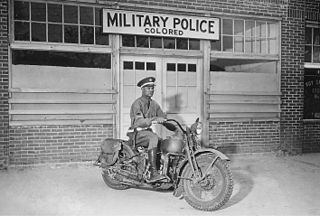
A series of policies were formerly issued by the U.S. military which entailed the separation of white and non-white American soldiers, prohibitions on the recruitment of people of color and restrictions of ethnic minorities to supporting roles. Since the American Revolutionary War, each branch of the United States Armed Forces implemented differing policies surrounding racial segregation. Racial discrimination in the U.S. military was officially opposed by Harry S. Truman's Executive Order 9981 in 1948. The goal was equality of treatment and opportunity. Jon Taylor says, "The wording of the Executive Order was vague because it neither mentioned segregation or integration." Racial segregation was ended in the mid-1950s.

Herbert Lloyd Wilkerson was a United States Marine Corps major general. A veteran of three wars, he was most noted for his service as commanding officer, 1st Marine Regiment during Vietnam War and later as commanding general, 3rd Marine Division.

The United States Army's Noncommissioned Officer Candidate Course (NCOCC), originally located at Fort Benning, Georgia, was created to fill the Army's critical shortage of junior noncommissioned officers with the best qualified and best trained men available. NCO Candidates (NCOC) allowed to attend the course were selected from volunteers and many candidates were among the brightest soldiers of Basic Combat Training, Advanced Individual Training or in a subsequent assignment that demonstrated outstanding leadership potential. The program was in existence only during the U.S. war in Vietnam.
References
- Notes
- 1 2 3 4 5 Stillman (1974), p.221
- ↑ "3 Marines Hurt in Lejeune Fight". The New York Times . July 24, 1969. p. 41.
- 1 2 3 4 "Text of Camp Lejeune Committee's Report to Commanding General". The New York Times. August 10, 1969. p. 67.
- ↑ Stillman (1974), pp. 221–229
- ↑ "Vietnam War Timeline". History.com.
- ↑ Fighting on Two Fronts: African Americans and the Vietnam War; Westheider, James E.; New York University Press; 1997; pp. 11–16.
- ↑ "Vietnam: The Soldier's Revolt".
- ↑ Johnson, Thomas A. (August 17, 1969). "Armed Forces: Racial Violence Mars Integration Record". The New York Times. p. E6.
- ↑ Stillman (1974), p. 222
- Bibliography
- Stillman II, Richard (May–June 1974). "Racial Unrest in the Military: The Challenge and the Response". Public Administration Review . 34 (3): 221–229. doi:10.2307/974906. JSTOR 974906.